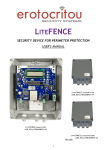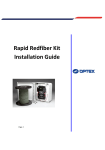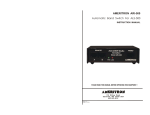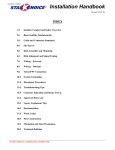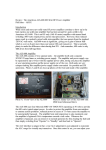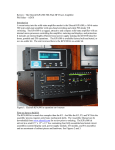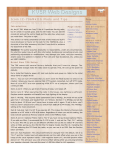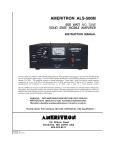Download Acom 600S Specifications
Transcript
Review: The “New” Ameritron ALS-600 600-Watt HF Power Amplifier Phil Salas – AD5X Introduction The compact and light-weight ALS-600 solid-state amplifier has been around for many years. Using four Motorola MRF-150 TMOS FETs operating at 50 volts, the ALS-600 provides 600 watts PEP SSB, 500 watts CW typical output power from 160-10 meters. It is simple to use (no tuning required), effective (only 4dB down from full legal limit), and reasonably priced. Internal protection circuits automatically protect the ALS-600 from improper operation, high SWR, or high heat-sink temperature. The ALC interface can be customized for any transceiver through a rear-panel adjustment control. Finally, accurate cross-needle meters read SWR/Peak Power on the amplifier, and voltage/current on the power supply. Now while the ALS-600 provides your basic amplifier features, new solid-state amplifiers on the market are offering additional features that many hams want. The “new” ALS-600 Amplifier Ameritron’s solution to the competition has been to quietly evolve the ALS-600 with small changes so options can be added for those who want them, while keeping the basic amplifier cost low for those who don’t need the additional features. First, Ameritron introduced a switching power supply option. As the ALS-600 consists of separate amplifier and power supply units, you can easily select either the less expensive linear power supply or the light-weight switching power supply. The switching power supply is 1/3rd the weight of the linear power supply, making it attractive for portable operation. The most recent change to the ALS-600 (Serial Numbers 14378 and higher) adds remote control and automatic transceiver band-change capability using either the ALS-500RC Remote Control Head, or the ARI-500 Automatic Band Switch – or both! These units were originally designed for use with the ALS-500M mobile amplifier, as this mobile amplifier is normally mounted remotely from the transceiver. Now these units also interface with the ALS-600 via a pair of amplifier front panel RJ45 jacks. ALS-600 amplifiers with lower serial numbers can be factory upgraded. Contact Ameritron for pricing. So - let’s take a look at each of these new optional control units. Photo A: RJ45 jacks (upper right) provide optional remote control capability. Photo B: New relay-switched low pass filter board permits remote band switching. ALS-500RC Remote Control Head The ALS-500RC allows you to remotely mount your ALS-600, yet still have access to the amplifier’s frequency switch and fault reset function (via the ALS-500RC POWER switch). It also provides amplifier RF output power monitoring, and DC PWR, TX (transmit) and O/L (fault/overload) LEDs. Anyone looking at your station will not realize that you have a 600 watt amplifier available! Compact ALS-500RC provides all ALS-600 control and monitoring. 600 watts out & no amp in sight! ARI-500 Automatic Band Switch The ARI-500 automatically selects the correct frequency range for the ALS-600 amplifier by reading band data from the transceiver. A pair of supplied 6-foot CAT-5 cables provides amplifier interfacing, and a 6-foot CAT-5 cable terminated with an RJ45 on one end is provided for making a transceiver interface cable. The manual provides detailed information so you can connectorize this cable for popular Icom, Kenwood, and Yaesu transceivers, the Elecraft K3 transceiver, and other equivalent transceivers. If you don’t want to build your own cable, Ameritron has pre-built cables for many popular radios. Besides controlling the amplifier’s frequency range, the ARI-500 has some additional desirable features. A low current-drive amplifier keying interface does away with the requirement for an external buffer for all transceivers. It even works with the low-drive HSEND output from the IC-706MKIIG and IC-7000 radios. The ARI-500 can also be strapped to automatically clear an amplifier bypass fault so you don’t have to manually reset your ALS-600. I’ve found this convenient as I get frequent ALS-600 SWR faults from birds landing on my high-Q MFJ-1775 rotatable dipole! If desired, you can plug the ALS-500RC Remote Control Head into the ARI-500 to remotely display ALS-600 RF output power and RX and O/L status. When plugged into the ARI-500, the ALS-500RC automatically defeats the ARI-500 auto-reset feature since the ALS-500RC provides manual STANDBY/OPERATE switching at your fingertips. In my opinion, the ALS-500RC is very convenient when the ARI-500 is not used and the ALS-600 is remotely located. However, I don’t really see the need for it when you have an ARI-500, and the ARI-500 is strapped for automatic fault reset. Let’s Fire-Up the ALS-600 with all the options The ALS-600 power supply comes wired for 120VAC operation so it is ready to plug into your wall outlet. However, you should plug the amplifier into a separate AC branch than the one your transceiver is connected to unless you have a 20-amp AC branch circuit (transceivers typically draw 3-4 amps, and the ALS-600 typically draws 11-14 amps). Connect a ground wire from the amplifier to your station’s single-point ground, and an ALC cable between the ALS-600 and your transceiver. Finally, connect the two RJ45 cables between the ARI-500 and the ALS-600, the RJ45 cable between the ALS-500RC and the ARI-500, and the transceiver interface cable between your transceiver and the ARI-500. Both the ALS-500RC and the ARI-500 are powered through the ALS-600 RJ45 interface cables, so no external DC voltage is required. The only set-up required is to set the ALS-600 band switch to REMOTE, and strap the ARI-500 for either auto- or manual fault re-set. There is also a strapping option in the ARI-500 to enable 10/12 meter operation if the ALS-600 is equipped with the optional 10/12 meter MOD10-MB kit. Once you turn on your ALS-600 and transceiver, the POWER and LINK LEDs on the ARI-500 will glow, indicating everything is connected properly and data is being received from your transceiver. ARI-500 on author’s transceiver. If used, the ALS-500RC.plugs into REMOTE A on the ARI-500. Amplifier interface cables connect to these ports on the rear of the ARI-500. While the ALS-500RC is very convenient for manual remote control of the ALS-600, the real “cat’s meow” is the ARI-500 Automatic Band Switch. It is very nice to change bands on my transceiver and have the amplifier follow. I really like this, especially since I’ve forgotten to manually change bands on my “old” ALS-600 more times than I’d care to admit – especially in the heat of a contest or trying to snag that rare DX. Fortunately the amplifier’s fault circuitry always protects the amplifier, as it has when I’ve accidentally transmitted into disconnected or shorted antenna runs! I should be more careful, but I have been spoiled by the effectiveness of the protection circuits. Performance Measurement I ran some basic performance measurements to check amplifier power and power meter accuracy using an external PowerMaster digital peak-hold wattmeter. For the peak SSB readings, I found that sending “dits” at about 10 WPM gave me similar readings as when using a long peak-hold wattmeter setting on voice while saying “hellooooo test one two three four”. I adjusted the transmitter drive while sending “dits” until the peak reading was 600 watts, or the maximum output the amplifier was capable of if I couldn’t get 600 watts out. Then I measured the key-down power and drive levels necessary to achieve this. As Table 1 shows, the “new” ALS-600 does a good job meeting its typical power output specifications. I also found the ALS-600 peak-reading wattmeter to be quite accurate – within my ability to read the amplifier’s analog meter. I really couldn’t see any difference between the ALS-600 power meter and the external digital power meter. TABLE 1: Amplifier Power Output Measurements (external digital wattmeter) Band Drive Key Dwn Peak SSB 160M 85 watts 500 watts 600 watts 80M 95 watts 480 watts 525 watts 40M 95 watts 500 watts 600 watts 20M 90 watts 500 watts 600 watts 17M 85 watts 500 watts 600 watts 15M 95 watts 500 watts 600 watts 12M 85 watts 500 watts 600 watts 10M 95 watts 500 watts 580 watts I also verified that the SWR protection shutdown occurs at 75 watts reflected power, corresponding to an SWR of 2.1:1 at 600 watts. Since the amplifier protects itself at an absolute value of 75 watts reflected power, operating into a higher SWR is possible by simply reducing your output power. But you really should address the high SWR issue. Alas – Nothing is Perfect You need to be aware that the ALS-500RC Remote Control Head loads the ALS-600 RF Power Meter, resulting in a half-power reading on the amplifier’s power meter. This is not considered a problem by Ameritron, as the ALS-500RC is normally used when the ALS-600 is remotely mounted and so the power meter isn’t readily visible. This is discussed in both the ALS-600 and ALS-500RC manuals. While the ARI-500 is a great addition to the ALS-600, there are a few things that would improve its functionality. First, the ARI-500 could be made more convenient for remote monitoring of your ALS-600. While you can use the ALS-500RC to provide amplifier status, it would be nice if the ARI-500 had TX and O/L indicator LEDs so you could monitor the amplifier’s status directly on an ARI-500 located at your operating position. Next, the ARI-500 automatically puts your ALS-600 in OPERATE whenever your transceiver is keyed, regardless of the OPERATE/STANDBY switch position on the ALS-600. So you must turn the amplifier power off if you want to check your drive level or operate your transceiver bare-foot. Therefore, an OPERATE/STANDBY switch mounted on the ARI-500 would also be nice. In order to address these issues, I built a very simple interface that plugs into the ARI500. See the supplemental article below for details. Conclusion The compact Ameritron ALS-600 solid-state amplifier Ameritron, now with remote control and automatic band changing options, is a very affordable unit with pricing and features that let it fit many budgets and operating locations. Note: The ALS-600 QSK modification discussed in the “Modifications” section of this web site is applicable to this new version of the ALS-600, as well as the older ALS-600. Supplemental Article – Control/Indicator Unit for the ARI-500 As discussed above, there are no ALS-600 status indicators on the ARI-500, and you must switch your ALS-600 off to run bare-foot or check exciter drive power. To remedy these “deficiencies”, I built a compact interface that plugs into the ARI-500 REMOTE A input that includes PWR, TX and O/L LEDs, and a STANDBY/OPERATE switch. The circuit is shown in Figure 1. While I made my own RJ45 cable interface, I’ve called out an RJ45 cable so you can just cut off the necessary cable length. The cable length is non-critical, but it should extend just 3” from the box to the end of the RJ45 connector if you want to mount the interface unit right on the ARI-500. All parts (Table 1) are from All Electronics (www.allelectronics.com). The photos show the internal wiring of the interface unit unit, and the unit mounted on the ARI-500 with double-sided tape. Labeling was done using Casio “White-on-Clear” labeling tape. J1-8 J1-1 1N4007 O/L (Red) 1 2 3 4 5 6 7 8 PWR (Grn) J1-7 STBY 4.7K J1-3/4 OPR RJ45 Panel (Socket) View 4.7K J1-2 TX (Yel) Figure 1: ARI-500 Interface Unit Schematic Wiring of ARI-500 Interface Unit. Interface Unit on ARI-500. Note: The last photo shows a highly modified ARI-500 that is the subject of another article. In order to use this interface unit, strap the ARI-500 as though the ALS-500RC is being used. Unlike the ALS-500RC however, this interface unit does not disable the ARI-500 auto-reset, nor does it load the ALS-600 RF power meter. Now I can mount the ALS-600 out of the way and still monitor TX and O/L status. And I can easily switch between OPERATE and STANDBY so I can check transceiver drive or switch between barefoot and full-power operation. Table 1 – ARI-500 Interface Unit parts list. All Electronics part numbers shown. QTY 1 1 1 1 2 1 1 1 Description Subminiature toggle switch Ultra-bright green LED Ultra-bright red LED Ultra-bright yellow LED 4.7K ¼-watt resistor 1N4007 2.36x1.36x0.8” plastic box 3-ft CAT5 cable Part Number SMTS-4 LED-57 LED-94 LED-72 4.7K-1/4 1N4007 1551-HBK CB-53 Price ea. $1.35 $2.00 $0.55 $0.95 5/$0.50 6/$1.00 $1.95 $2.35







